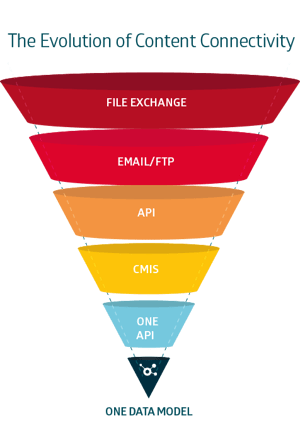Popular resources
Popular resources
Our one-size-fits-all data model
The Xillio Unified Data Model (UDM) consists of a data model and API, built on top of MongoDB. In short, the UDM is our one-size-fits-all data model that we use to store data in-between extraction and import.
How does the UDM work?
Extracted data from the source system is converted to the UDM using templates. One or more transformation operations (e.g. deduplication, restructuring, improving metadata) can be performed directly on the data in the UDM. The data is converted from UDM to the data type required for the target system using templates.
Finally, the converted data is imported in the target system.
From floppy disk to one data model The exchange of information has since it’s early days always been a main theme in Information Technology. In the 80’s this started with simple file exchange on floppy disks. In the 90’s the dominant methods for exchange became email and ftp.
The exchange of information has since it’s early days always been a main theme in Information Technology. In the 80’s this started with simple file exchange on floppy disks. In the 90’s the dominant methods for exchange became email and ftp.
It wasn’t until the 2000’s that vendors started to implement standard API’s (often using SOAP) for exchanging information. Although widely used (even until today), the vendor specific approach led to a fragmented market in which it is difficult to get information in or out of systems.
While things improved for markets in which structured content played an important role; unstructured content (e.g. documents & files) remained problematic. A major attempt at standardizing information exchange between repositories for unstructured content was made with the CMIS standard. Unfortunately, the standard never became widely adopted. It suffered from being complex, vendor’s having different views on how to implement it, and most importantly: not having a standardized way of representing the actual content.
Content-as-a-Service
Xillio now solves the last bit of the puzzle by introducing the Unified Data Model: A standardized way of describing content that enables an extremely simple yet powerful API.
The UDM enables the concept of content-as-a-service. Content becomes a commodity that users can directly access in business and consumer applications on premise and in the cloud without having to worry about where the content exactly resides.
Xillio is the world's leading content migration company. We offer cutting-edge technology and services to help organizations maximize the value of their content, no matter where it is stored. As a Microsoft Content AI Preferred Partner, Xillio ensures seamless integration and superior performance.
%20(300%20x%2060%20px)%20(3).png?width=635&height=127&name=ISO%20email%20signature%20(390%20x%2060%20px)%20(300%20x%2060%20px)%20(3).png)
|
Xillio Europe
Xillio UK
Xillio USA
Send an email to sales@xillio.com